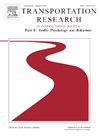浏览担忧:澳大利亚父母对青少年使用拼车服务的看法
IF 3.5
2区 工程技术
Q1 PSYCHOLOGY, APPLIED
Transportation Research Part F-Traffic Psychology and Behaviour
Pub Date : 2025-04-17
DOI:10.1016/j.trf.2025.04.010
引用次数: 0
摘要
澳大利亚的拼车服务越来越受欢迎,允许个人雇佣一名司机,使用他们的私家车直接将他们送到目的地。这些拼车服务可以在与其他乘客共享车辆或在沿途额外停靠的情况下进行。随着拼车服务使用量的增加,2024年4月推出的优步青少年(Uber Teen)为青少年提供了独立的交通工具,这凸显了了解父母及其十几岁孩子对这些服务的看法和使用模式的必要性。方法对652名澳大利亚父母(平均年龄45.7岁,SD = 9.2岁;(58.7%为女性),探讨他们对青少年使用拼车服务的态度和行为,包括有成年人陪同和无人陪同的情况。进行了逻辑回归分析,以确定与青少年无人陪伴拼车使用相关的因素。结果近三分之二(62.6%)的受访者在过去三个月内曾亲自使用拼车服务,46.1%的受访者曾与青少年一起使用拼车服务,18.3%的受访者表示他们的青少年曾在无人陪伴的情况下使用拼车服务。影响青少年无人陪伴拼车使用的显著因素包括:既往拼车经历、父母年龄、青少年年龄和父母驾驶过失(χ2(5) = 106.608, p <;0.001)。这些发现强调了安全性和可靠性在父母对青少年无人陪伴使用拼车服务的决定中所起的关键作用。随着像优步青少年这样的服务越来越多,政策制定者和服务提供商必须解决这些问题,并加强安全措施,更有效地支持青少年用户。本文章由计算机程序翻译,如有差异,请以英文原文为准。
Cruising through concerns: Australian parents’ views on teen rideshare service use
Objectives
Rideshare services in Australia are increasingly popular, allowing individuals to hire a driver who uses their personal vehicle to transport them directly to their destination. These rideshare services can occur with or without sharing the vehicle with other passengers or making additional stops along the route. The rising use of rideshare services is coupled with the introduction of Uber Teen in April 2024, which offers independent transportation for teenagers and underscores the need to understand the perception of these services and use patterns among parents and their teenage children.
Methods
An online survey was completed by 652 Australian parents (mean age = 45.7 years, SD = 9.2 years; 58.7 % female) to explore their attitudes and behaviours toward their teenagers’ use of rideshare services, both when accompanied by an adult and when unaccompanied. A logistic regression analysis was performed to identify factors associated with teenagers’ unaccompanied rideshare use.
Results
Nearly two-thirds of the participants (62.6 %) had personally used a rideshare service in the past three months, 46.1 % had used a rideshare service with their teenager, and 18.3 % reported that their teenager had used a rideshare service unaccompanied. Significant factors influencing teenagers’ unaccompanied rideshare use included prior rideshare experience, parent age, teenager age, and parental driving lapses (χ2(5) = 106.608, p < 0.001).
Conclusions
These findings emphasise the critical role of safety and reliability in parents’ decisions regarding their teenagers’ unaccompanied use of rideshare services. With the growing presence of services like Uber Teen, it is vital for policymakers and service providers to address these concerns and strengthen safety measures to support teenage users more effectively.
求助全文
通过发布文献求助,成功后即可免费获取论文全文。
去求助
来源期刊
CiteScore
7.60
自引率
14.60%
发文量
239
审稿时长
71 days
期刊介绍:
Transportation Research Part F: Traffic Psychology and Behaviour focuses on the behavioural and psychological aspects of traffic and transport. The aim of the journal is to enhance theory development, improve the quality of empirical studies and to stimulate the application of research findings in practice. TRF provides a focus and a means of communication for the considerable amount of research activities that are now being carried out in this field. The journal provides a forum for transportation researchers, psychologists, ergonomists, engineers and policy-makers with an interest in traffic and transport psychology.

 求助内容:
求助内容: 应助结果提醒方式:
应助结果提醒方式:


